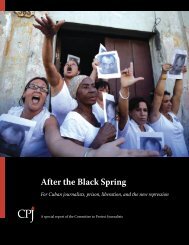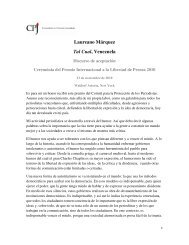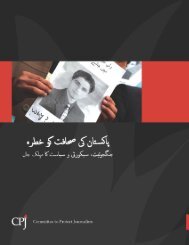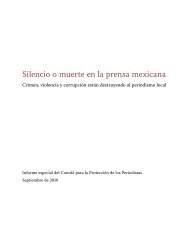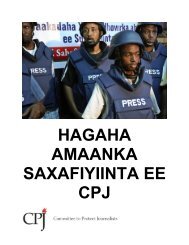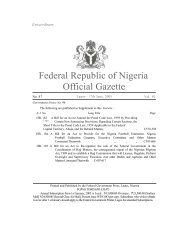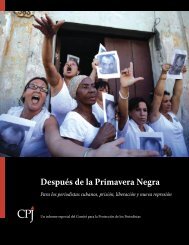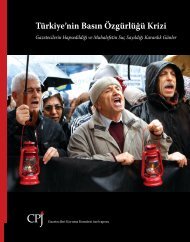Attacks on the Press - Committee to Protect Journalists
Attacks on the Press - Committee to Protect Journalists
Attacks on the Press - Committee to Protect Journalists
- No tags were found...
Create successful ePaper yourself
Turn your PDF publications into a flip-book with our unique Google optimized e-Paper software.
attacks <strong>on</strong> <strong>the</strong> press in 2009asia: analysisIrish-British nati<strong>on</strong>al Stephen Farrell. A Canadian reporter, Michelle Lang, embeddedwith troops from that country, was killed by a roadside bomb near Kandahar.C<strong>on</strong>diti<strong>on</strong>s did not deteriorate <strong>to</strong> <strong>the</strong> same levels faced by <strong>the</strong> press in Iraq,where 140 journalists and51 media support workerswere killed and dozensmore were abducted, mos<strong>to</strong>f <strong>the</strong>m between 2003 andInternati<strong>on</strong>al news outletstake heightened precauti<strong>on</strong>s inAfghanistan, Pakistan.<strong>the</strong> end of 2008. Yet some parallels exist. As in Iraq, c<strong>on</strong>flict pitted a range ofinsurgent and criminal groups against well-equipped military forces and weakcentral governments. Local journalists in Pakistan and Afghanistan providedmuch of <strong>the</strong> fr<strong>on</strong>t-line coverage and were often exposed <strong>to</strong> great risk, a situati<strong>on</strong>that existed in Iraq.Internati<strong>on</strong>al news organizati<strong>on</strong>s <strong>to</strong>ok heightened precauti<strong>on</strong>s in <strong>the</strong> twocountries but had not yet established <strong>the</strong> sort of armed, fortified compounds thathoused <strong>the</strong>ir operati<strong>on</strong>s in Baghdad. Internati<strong>on</strong>al news coverage, particularly inAfghanistan, increased al<strong>on</strong>g with <strong>the</strong> level of fighting. U.S.-based news outletsdevoted greater staffing, more airtime, and more print space <strong>to</strong> <strong>the</strong> c<strong>on</strong>flict inAfghanistan, making it, by late year, <strong>the</strong> <strong>to</strong>p news s<strong>to</strong>ry in <strong>the</strong> United States for<strong>the</strong> first time as judged by <strong>the</strong> Pew Research Center’s Project for Excellence inJournalism.As in Iraq, increasing risk brought with it greater limitati<strong>on</strong>s <strong>on</strong> access. WhilePakistani reporters could embed with <strong>the</strong> nati<strong>on</strong>’s military <strong>to</strong> cover <strong>the</strong> fighting,military rules prevented <strong>the</strong>m from reporting everything <strong>the</strong>y saw. While journalistsin Afghanistan could still move relatively freely in Kabul, reporting trips <strong>to</strong>places such as Kandahar and Kunduz now had <strong>to</strong> be weighed against <strong>the</strong> increasingrisks <strong>the</strong>re.The Pakistani government launched two major military offensives in 2009,<strong>on</strong>e in<strong>to</strong> <strong>the</strong> Swat Valley and surrounding areas beginning in April, and <strong>the</strong>n apush in<strong>to</strong> <strong>the</strong> heart of <strong>the</strong> Federally Administered Tribal Areas in Oc<strong>to</strong>ber, aimedat <strong>the</strong> core of <strong>the</strong> Taliban’s Pakistan-based leadership. In <strong>the</strong> provincial capital ofPeshawar in <strong>the</strong> midst of <strong>the</strong> c<strong>on</strong>flict z<strong>on</strong>es, many local reporters from <strong>the</strong> surrounding<strong>to</strong>wns under attack <strong>to</strong>ld CPJ that both <strong>the</strong> militants and <strong>the</strong> militaryhad made it more difficult than ever <strong>to</strong> report independently.During <strong>the</strong> Swat Valley offensive, as many as 260 local reporters wound upjoining <strong>the</strong> general populati<strong>on</strong> in fleeing <strong>the</strong> all-out attacks by <strong>the</strong> Pakistani military,according <strong>to</strong> <strong>the</strong> Khyber Uni<strong>on</strong> of <strong>Journalists</strong>. Some stayed behind <strong>to</strong> take<strong>the</strong>ir chances, but <strong>the</strong>ir coverage was severely limited by <strong>the</strong> threat of retaliati<strong>on</strong>.Sher Khan Afridi, president of <strong>the</strong> Khyber Uni<strong>on</strong> of <strong>Journalists</strong>, said <strong>the</strong> homesof at least six journalists had been targeted and destroyed by militants angeredby news coverage.One home bel<strong>on</strong>ged <strong>to</strong> Rahman Bunairee, a popular reporter for KhyberTV, a nati<strong>on</strong>al, privately owned broadcaster, and <strong>the</strong> U.S. government-fundedVoice of America’s Deewa service, which targets <strong>the</strong> Pash<strong>to</strong>-speaking audiencein <strong>the</strong> Pakistan-Afghanistan border area. Militants <strong>to</strong>ld Bunairee’s family <strong>the</strong>ywere retaliating for his reporting. “They had come <strong>to</strong> destroy our house, and <strong>the</strong>y<strong>to</strong>ld us so. They <strong>to</strong>ld my fa<strong>the</strong>r, ‘We have orders <strong>to</strong> blow up <strong>the</strong> house because ofyour s<strong>on</strong>’s criticism of <strong>the</strong> Taliban,’” Bunairee <strong>to</strong>ld CPJ. In <strong>the</strong> face of c<strong>on</strong>tinuingthreats he fled <strong>the</strong> country <strong>to</strong> live in <strong>the</strong> United States.Because of <strong>the</strong> dangers faced by local reporters, much of <strong>the</strong> coverage wasprovided by Pakistani journalists from outside <strong>the</strong> regi<strong>on</strong> who embedded with<strong>the</strong> military. Shamsul Islam Naz, secretary-general of <strong>the</strong> Pakistan Federal Uni<strong>on</strong>of <strong>Journalists</strong>, <strong>to</strong>ld CPJ that <strong>the</strong> military routinely suppressed s<strong>to</strong>ries about <strong>the</strong>impact of <strong>the</strong> fighting <strong>on</strong> <strong>the</strong> local populace. O<strong>the</strong>r journalists interviewed byCPJ also noted <strong>the</strong> military’s tight restricti<strong>on</strong>s <strong>on</strong> embedded reporting.Muhammad Arshad Sharif, a corresp<strong>on</strong>dent for Dawn TV News who embeddedwith <strong>the</strong> military during <strong>the</strong> Swat offensive, acknowledged that some eventswere not disclosed in news reports from embedded reporters. “For example,” hesaid, “you can’t show <strong>the</strong> damage and dead bodies if it’s bad for <strong>the</strong> military.“But at least you’re part of his<strong>to</strong>ry as it is happening, even if you can’t tell <strong>the</strong>whole s<strong>to</strong>ry,” added Sharif, who offered hope that “we can show all our footagelater, <strong>to</strong> show <strong>the</strong> violati<strong>on</strong> of human rights of war.” For Sharif, embedding wasa necessary tactic in a situati<strong>on</strong> that offered few attractive opti<strong>on</strong>s. “Ei<strong>the</strong>r youcover it from <strong>the</strong> side of <strong>the</strong> militants or go over and cover it from <strong>the</strong> side of <strong>the</strong>government. Cover it independently and your life is at risk. Your life can be takenaway because you could be a target of ei<strong>the</strong>r of <strong>the</strong> two sides,” Sharif said.Between 2001 and 2009, at least 22 journalists were killed in c<strong>on</strong>necti<strong>on</strong> <strong>to</strong><strong>the</strong>ir work in Pakistan, all but two of <strong>the</strong>m local reporters and pho<strong>to</strong>graphers.The Pakistani militaryallows reporters <strong>to</strong> embedbut censors <strong>the</strong> coverage.Three of <strong>the</strong> four deaths in 2009came at <strong>the</strong> hands of militants, but<strong>the</strong> Pakistani army also came undercriticism for recklessly endangeringreporters. In June, troops manninga checkpoint in Malakand fired <strong>on</strong> AVT Khyber cameraman Malik Imran and<strong>the</strong> crew’s driver. The journalists said <strong>the</strong>ir car was hit after it had cleared <strong>the</strong>checkpoint. The army never issued a statement or clarificati<strong>on</strong>, but an angeredPakistan Federal Uni<strong>on</strong> of <strong>Journalists</strong> did, saying that “such incidents have become<strong>the</strong> order of <strong>the</strong> day in c<strong>on</strong>flict areas.” When CPJ met with reporters in1081 0 9




